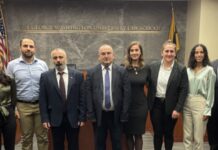By Edmond Y. Azadian
During a recent visit to Armenia, I took a side trip to Nagorno Karabagh. Love for our historic homeland certainly contributes to endearing that piece of land to all Armenians. But that love and admiration still will be there if you evaluate Karabagh in absolute terms, looking at it from an artistic perspective.
The capital, Stepanakert, has become a modern city, a pride of the Karabagh people.
The natural lush and Alpine beauty, combined with a sense of history, led me to ponder about this paradise on earth: Who is contributing to its development? Who is guarding its borders? Who is investing in its economy?
There is virtually no air traffic between Yerevan and Stepanakert, since the Azeris have been threatening to shoot down civilian aircraft. Every time Armenia attempts to begin air transport, the Organization for Security and Cooperation in Europe (OSCE) and other “impartial” parties warn that country not to resort to provocations. Thus, the Azeri diktat of an internationally-supported policy to isolate Karabagh and down the road, to force its depopulation, is enforced.
Therefore, the only way to communicate with the enclave or to visit there remains overland transport, which under ideal conditions, takes a minimum of six hours from Yerevan through Goris. The road does not meet international standards, but in local standards, it is considered comfortable.









